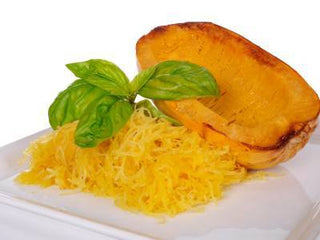(cucurbita pepo)
Spaghetti squash is a relative of the cucumber and the melon. The squash is botanically classified as a fruit although it is considered a vegetable in cooking. Also known as vegetable spaghetti and noodle squash, spaghetti squash is a variety of winter squash.
Spaghetti squash has an oblong shape and averages between 4 and 8 pounds. The shell of spaghetti squash is difficult to pierce and the orange or yellow hard flesh surrounds a hollow inner cavity filled with seeds.
Once prepared, spaghetti squash stands out from other winter squash. With cooking, the flesh falls away from the inner cavity into strands reminiscent of spaghetti. These “spaghetti” strands are crisp and mildly sweet in flavor. You can surprise and delight young children by showing them how this vegetable transforms with cooking.
The flesh of spaghetti squash ranges from ivory to yellow or even orange in color. The orange variety, now frequently found in grocery stores, was developed in the 1990s and is referred to as “orangetti”. This darker variety is a bit sweeter than its paler counterparts.
Spaghetti squash was first cultivated from wild squash growing in the region between Guatemala and Mexico some 10,000 years ago. Originally cultivated for the seeds, spaghetti squash (along with corn and beans) was considered one of the “Three Sisters” of Native American agriculture.
Today we pay homage to the roots of this indigenous treat - the word squash is derived from the Native American word akutasquash. With Thanksgiving fast approaching, it seems appropriate to learn more about one of the first foods the Native American’s offered to the Pilgrims.
Nutrition Facts
Although we may tend to think of spaghetti squash as a starchy vegetable (about 90% of the total calories come from carbohydrates), a cup of cooked squash contains just 10 grams of carbs of which 2 are from fiber. This compares favorably to the 43 grams of carbs found in a cup of spaghetti pasta (of which 36 grams is from starch). At just 42 calories per cup, spaghetti squash is much lower than the 221 calories found in the pasta.
While not the nutrition powerhouse of other vegetables, spaghetti squash is a good source of vitamin C, providing 9% of daily values. This winter squash also contains a small amount of niacin, vitamin B6 and pantothenic acid. A serving of spaghetti squash also contains 181 mg of potassium.
Selection and Storage
Although spaghetti squash can be found throughout the year, it is best in October and November when it is at the peak of the season.
When selecting spaghetti squash, look for one that is smooth and round, heavy for the size. The squash should have a nice, lemon yellow color with a firm, dry, cork-like stem. Avoid those with cracks or soft spots, green coloring or no stem. A squash without a stem permits bacteria to enter.
Because spaghetti squash are picked at maturity make sure to select a squash that is ripe. If you are unsure, give it the finger nail test. If you can press your fingernail into it or easily scrape off some skin the squash is not ripe enough. Remember when selecting - the larger the squash, the thicker and more flavorful the strands.
Spaghetti squash can be stored in a cool, dark place for up to three months. The only time spaghetti squash should be stored in the refrigerator is if it has been cut and wrapped in plastic. Spaghetti squash also freezes well. Pack cooked squash in a plastic bag. After partially thawing, steam for about five minutes or until tender.
Recipes
Spaghetti squash can be baked, steamed or micro waved. Before cooking, wash the rind and dry. Using a large knife, carefully cut the squash lengthwise. If the squash is difficult to cut, pierce with a fork and microwave for a few minutes. Once the squash is cut in half, scoop out the seeds and soft inner flesh.
If steaming, place flesh side down in a pot with about 2 inches of water. Steam until flesh is soft, about 20 minutes. If microwaving, prepare squash in same manner and place in a glass dish. Cover with saran wrap and cook 7 to 10 minutes. Be very careful not to burn yourself when removing the saran wrap!
If time permits, baking is best as this method brings out the flavor of the squash. After cutting and cleaning out the squash, sprinkle with a little olive oil, pepper and salt. Place on a flat pan flesh side down. Bake at 375 degrees for 45-60 minutes. Once the squash is cooked, scoop or fork out the spaghetti strings.
Perhaps the best way to try this winter squash is by substituting spaghetti with the squash the next time pasta is on the menu. You can toss spaghetti squash with marinara, pesto or any other sauce that is served over pasta.
For a flavorful side-dish, try Herbed Spaghetti Squash but substitute butter with olive oil. If you want to try a twist on a traditional favorite serve our delicious Shrimp Scampi over spaghetti squash. For a prize winning dish that is a bit time consuming try Spaghetti Squash with Chicken, Mushrooms and Spinach.
The seeds of spaghetti squash can be enjoyed as a delicious snack food. Place seeds in a single layer on a cooking sheet and roast at around 160 degrees for 15-20 minutes. Roasting the seeds at such a low temperature minimizes the damage to their healthy oils.
Fun Facts
Spaghetti squash plants occasionally cross-pollinate with zucchini plants.

